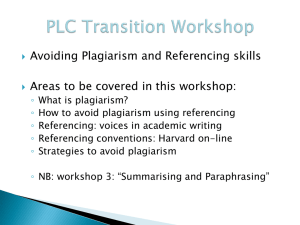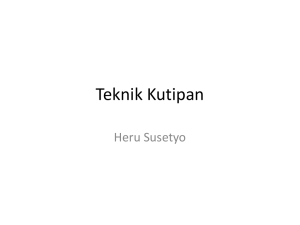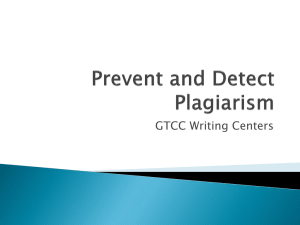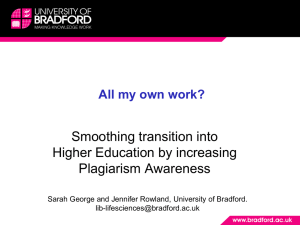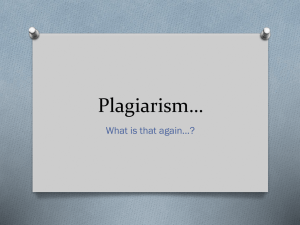Avoiding Plagiarism
advertisement
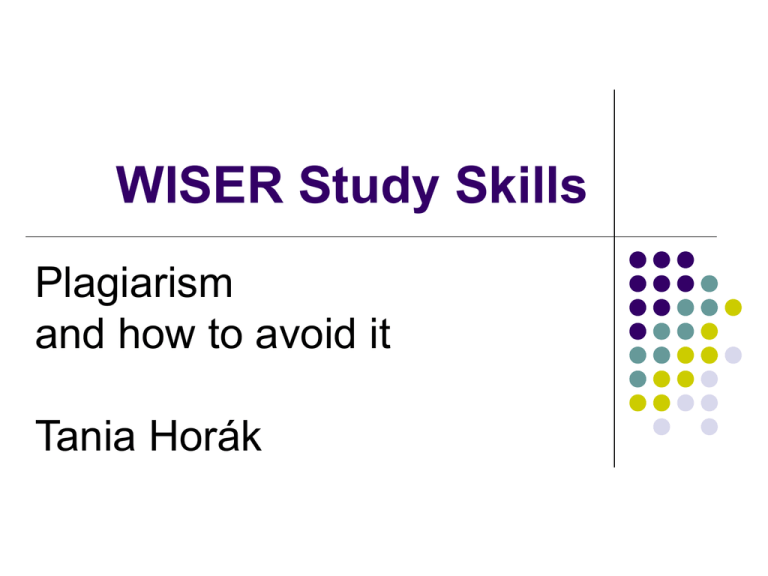
WISER Study Skills Plagiarism and how to avoid it Tania Horák Overview Plagiarism Principles of referencing The Harvard Referencing System Quoting and Paraphrasing Summary Discuss with at least one other person: What is plagiarism? How can you avoid it? What are the penalties for plagiarising? Plagiarism The theft or use of someone else's work without proper acknowledgement, presenting the material as if it were your own. University policy The work I submit should always be entirely my own work. Copying from other students is OK as long as you change it a little bit. Copying by hand, out of books is OK: that’s what we’ve got a library for. You should never quote someone else: everything should be in your own words. Quoting someone else is acceptable if you put their name in the acknowledgements. University policy You have to put the complete details of the source you quoted from at the end of your essay. The university doesn’t like us looking up things on the internet because it’s like cheating. You can reuse stuff from your own essays earlier in the course because it’s your own. You’ll get some marks taken off if you are found to have copied material. The point of coursework is to make sure we’ve understood the course material. University policy Diagrams and pictures don’t need to be acknowledged. If I don’t use exactly the same words, I haven’t copied. You could be expelled from your course for copying material for coursework. Reproducing existing material “in quotes” is enough to show that I’m not cheating. Penalties for plagiarism Single offence : 0% for the module with an opportunity to re-submit for a maximum mark of 40% for the module. Repeat offence: 0% for the module with no opportunity for re-submission. Reasons students give for plagiarism. “I got desperate at the last moment.” “I could not keep up with the work.” “I have to succeed. Everyone expects me to succeed and I expect it, too.” “I don’t understand what I’m expected to do to avoid plagiarism.” “I can’t do this! I’ll have to copy.” “But paraphrasing would be disrespectful (or dangerous, nonsense etc)” Why do we use other writers’ work in our essays? To explain the background to our study. To show that we have understood what we have read. To show the contribution a writer has made to the field. To show the relevance of a writer’s work to our argument/study. To provide authoritative support for our own argument. Avoiding Plagiarism Principles of Referencing You will have to read many books, journals and other sources to get the information for your assignments. Your tutor must be able to see what information is from which source. Tutors want to be able to see what parts are from your research & reading and what parts are your ideas. The Harvard Referencing System Harvard referencing 2 elements: 1) In-text citations Example: Some critics believe modern society suffers from a tendency to oversimplify issues (Brown 2001). Harvard referencing 2 elements: 1) In-text citations Example: Some critics believe modern society suffers from a tendency to oversimplify issues (Brown 2001). 2) A reference list at the end of the text In-Text Citation Always include who? and when? 2 ways to make a citation (reference): Example: Brown complains of a trend he calls, ‘the dumbing down of modern society’ (2001: 26). Example: Some critics believe modern society suffers from a tendency to oversimplify issues (Brown 2001). Reference List What? A list of all the references you cited in your assignment How? List your references alphabetically by author surname. Check your course handbook for how to set out the details. Be consistent. Reference List (contd) Why? So another reader can find the material you drew on in your work Don’t lose ‘easy’ marks by not providing a well laid out reference list. Reference List – an example Esmond, A.S. (1989) The Ending of Roman Britain. London & New York: Routledge. Hill, D. (1998) Unity and Diversity – a Framework for the Study of European Towns. pp 1-17 In: Hodges, R. & Hobbley, B. (eds) The rebirth of towns in the west AD700-1050, CBA Research Report 68: York: Council for British Archaeology. UNRV History, 428 AD An Ordinary Year at the End of the Roman Empire, Available at: http://www.unrv.com/?p=1355 (accessed on 1/9/2011) Wacher, J. (1999) The Towns of Roman Britain. Journal of Antiquity 39 (2):46-55 Author family name Author initials Year of publication Esmond, A.S. (1989) The Ending of Roman Britain. London & New York: Routledge. Title Place of publication Publisher Author family name Author initials Year of publication Title Wacher, J. (1999) The Towns of Roman Britain. Journal of Antiquity 39 (2):46-55 Name of the Journal Journal volume number Journal issue number Location and length of article Name of author/ organisation Title of article/ webpage UNRV History, 428 AD An Ordinary Year at the End of the Roman Empire, Available at: http://www.unrv.com/?p=1355 (accessed on 1/9/2011) URL (web address) The date you read this online article Avoiding Plagiarism 1 ) Using Quotes A quote is the exact words of another writer. Always give an in-text citation. Example: ‘TV reflects the dumbing down of modern society’ (Brown, 2001:26). Using Quotes Tutors want to read YOUR words, so avoid too many (or too long!) quotes. Using too many quotes gives the impression you have no ideas of your own OR that you don’t understand what you have read. Only use a quote if the author is saying something particularly bold, controversial or interesting, or says it in a way you simply cannot improve on! Avoiding Plagiarism 2) Paraphrasing Put the author’s ideas or information in your own words Always give an in-text citation. Paraphrasing Example: Source: ‘TV reflects the dumbing down of modern society’ (Brown, 2001:26). Paraphrases: Some critics believe modern society, as portrayed on TV, suffers from a tendency to oversimplify issues (Brown 2001). Brown (2001) points out modern society, as portrayed on TV suffers, from a tendency to oversimplify issues Paraphrasing Example: Source: ‘TV reflects the dumbing down of modern society’ (Brown, 2001:26). Paraphrases: Some critics believe modern society, as portrayed on TV, suffers from a tendency to oversimplify issues (Brown 2001). Brown (2001) points out modern society, as portrayed on TV suffers, from a tendency to oversimplify issues How to paraphrase… Read the source Understand the source Put the source away Make a list of main points you remember Write full sentences from your list of points Read paraphrase for correct grammar etc Check paraphrase against the source A Good Paraphrase is… ACCURATE (the ideas are the same as the source) ORIGINAL (the language is different from the source) GRAMMATICAL REFERENCED Which of these is acceptable behaviour? 1. 2. 3. 4. 5. 6. Copying a paragraph word for word from a source without any acknowledgement Copying a paragraph and making small changes e.g. replacing a few verbs, replacing an adjective with a synonym + source given in the list of references. Cutting and pasting a paragraph by using sentences of the original but omitting one or two and putting one or two in a different order. No quotation marks. In text citations e.g. (Jones 1999) and a reference list are included. Composing a paragraph by taking short phrases of 10 to 15 words from a number of sources and putting them together, adding words of your own to make a coherent whole. All sources included in reference list. Paraphrasing a paragraph with substantial changes in language and organisation; the new version will also have changes in the amount of detail used and the examples cited. In text citations e.g. (Jones 1999) and a reference list are included. Quoting a paragraph by placing it in block format or quoting shorter texts in quotation marks. Source is cited in text + list of references. Which of these is acceptable behaviour? 1. 2. 3. 4. 5. 6. Copying a paragraph word for word from a source without any acknowledgement Copying a paragraph and making small changes eg replacing a few verbs, replacing an adjective with a synonym + source given in the list of references. Cutting and pasting a paragraph by using sentences of the original but omitting one or two and putting one or two in a different order. No quotation marks. In text citations e.g. (Jones 1999) and a reference list are included. Composing a paragraph by taking short phrases of 10 to 15 words from a number of sources and putting them together, adding words of your own to make a coherent whole. All sources included in reference list. Paraphrasing a paragraph with substantial changes in language and organisation; the new version will also have changes in the amount of detail used and the examples cited. In text citations e.g. (Jones 1999) and a reference list are included. Quoting a paragraph by placing it in block format or quoting shorter texts in quotation marks. Source is cited in text + list of references. Summary Make sure you know what plagiarism means. how to avoid it. how to use the Harvard Referencing system. how to use the referencing guidelines from your School. Further information See the WISER website at www.uclan.ac.uk/wiser for useful info such as guidelines on the Harvard Referencing System. Also see WISER eLearn site – sign up asap! Find material on how to improve your study skills and academic writing References: Caroll, J (2002) AQ Handbook for Deterring Plagiarism in Higher Education, Oxford: OCSLD
